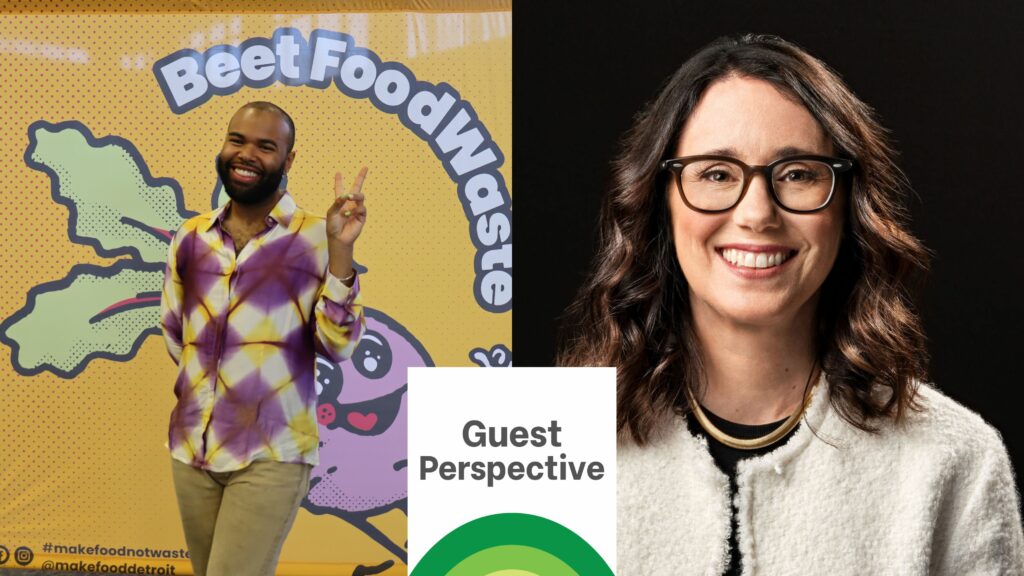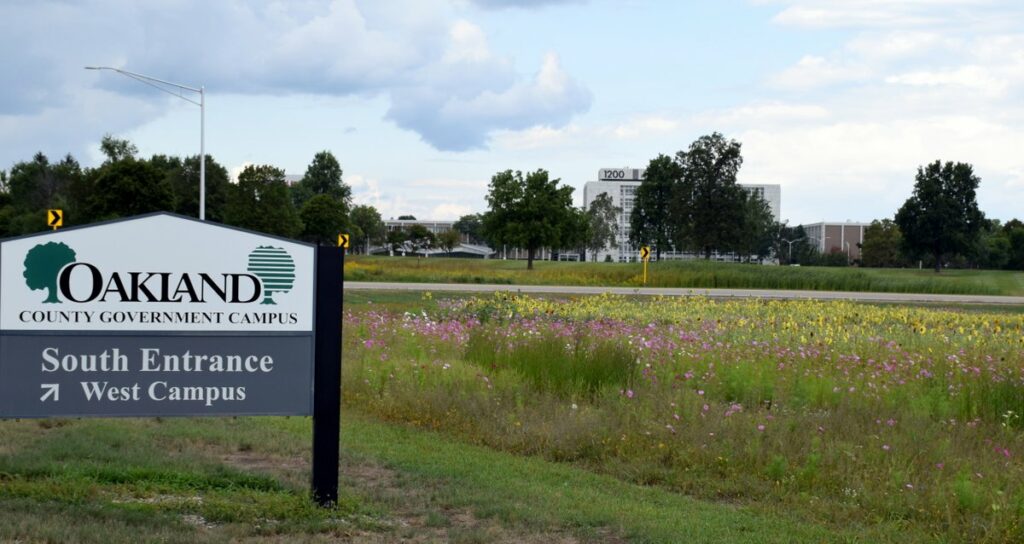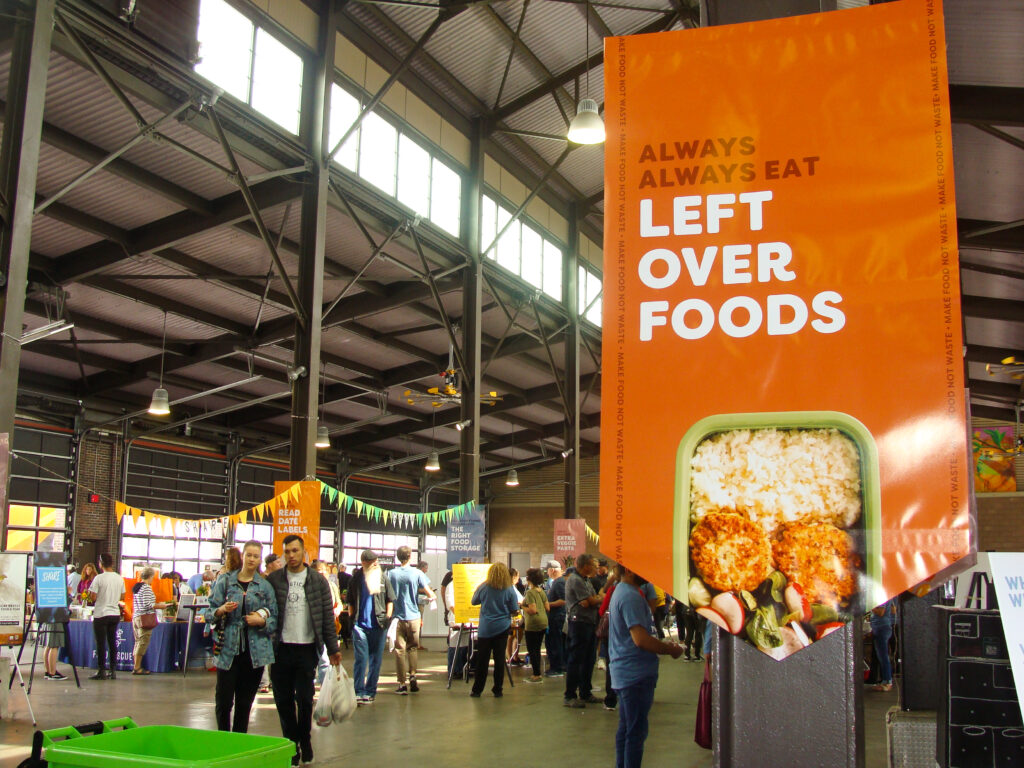Green Goals in Higher Education

In May, Edna Lorenz, PE, CEM, LEED AP, took on the role of Director of the Office of Campus Sustainability at Wayne State University. Previously, she served as the Energy Director at Corewell Health (formerly Beaumont Health), where she led a comprehensive energy and carbon reduction program across 22 hospitals. Before Corewell Health, Lorenz was a senior associate at Environmental Systems Design (now Stantec) in Chicago, managing LEED certification projects, energy audits, and renewable energy analysis. Here, she discusses the role, priorities, and future of sustainability at the university with SBN Detroit. Q: What led you to your current position? A: I am a mechanical engineer by training, having graduated from the University of Michigan. My first job out of college was with an engineering firm where I focused on energy and sustainability consulting for commercial buildings, with a specialization in the LEED green building rating system. In 2016, I took a position as Energy Director for the Beaumont Health System, now Corewell Health. While at Corewell, I found it very rewarding working on the operational side of the built environment, specifically optimizing building performance to reduce the energy consumption and carbon footprint of the hospital system’s 22 campuses. However, I wanted to get back to my green roots. I transitioned to higher education and began my role at Wayne State in May. It’s been fulfilling to work with a larger community, both on campus and within Detroit, who are deeply committed to sustainability. The students in particular are enthusiastic and have high expectations, which is very energizing. Q: What are your top priorities in this new role? A: My primary focus is to operationalize sustainability across the campus. We have a strategic framework, and I want to ensure our approach is practical and achievable for those executing the work. Initially, we are benchmarking current processes to identify what is working well, what isn’t, and where gaps exist. I am also collaborating with the academic side to integrate sustainability into all aspects of university life. Energy reduction is a top priority, and we have a strategic goal to reduce carbon emissions from building operations by at least 50% by 2030. Currently, we’re evaluating our buildings to find opportunities for both operational optimization as well as infrastructure improvement. Additionally, we are enhancing our waste management program by benchmarking current practices and identifying areas for improvement. We’re also focused on landscape and hardscape management to improve stormwater management and increase site permeability. We’re adding more trees and removing or replacing concrete with permeable pavers to achieve this and to enhance the campus’s appeal as a park-like community resource. Q: What strategies is the university implementing to reduce its carbon footprint? A: One great example is our student-run compost program. Our ‘Compost Warriors’ collect pre-consumer food waste — food scraps from food prep on campus — and transport it to the Georgia Street Collective, where it’s processed into nutrient-rich compost. Our grounds crew then uses it to fertilize the landscaping on campus. It’s a closed-loop process that reduces our carbon footprint while supporting a local organization. However, much of our scope 1 and 2 carbon emissions come from energy consumed by our buildings on campus. An example of how we are trying to reduce these emissions includes the installation and enhancement of automated controls for our buildings’ HVAC and electrical systems. By having the most up-to-date automation we can optimize how our buildings operate, from adjusting temperature controls based on outside conditions to turning off equipment when it is not needed. Q: What about recycling on campus? A: We are still working on benchmarking this area and have found it challenging to obtain accurate data due to the size of campus operations. Therefore, one of our first initiatives is to enlist students to help map waste stations around campus so we can chart the flow of waste leaving campus. We are also assessing the different types of waste streams, from hazardous waste from labs to construction waste from building renovations and used sports gear from the athletic department. Our aim is to identify all waste streams and find ways to divert as much as possible from landfills. Finally, we’re also looking at expanding the compost program at the Towers Café, a residential dining hall, with a pilot program this fall to divert post-consumer food waste as well as educate students on reducing overconsumption. Q: How are you addressing stormwater runoff management? A: Stormwater management is a significant issue in Midtown, where urban flooding has occurred. It’s a priority for us and our neighbors to explore ways to reduce runoff and prevent future flooding events. One of our major initiatives is to reduce hardscape and install more bioswales on campus as well as plant more trees and native vegetation. This will help reduce runoff and absorb more water onsite. A couple of examples of the progress we have made include installing permeable pavers on Anthony Wayne Drive in front of the residence hall as well as annual tree planting volunteer events with the Green Warrior student organization and our grounds crew. Q: What are the sustainable practices unique to the urban built environment? A: Being in an urban environment has its advantages. We have access to public transportation, and students and faculty can easily walk or bike to local amenities, which reduces fossil fuel emissions and the immense energy and materials needed to build private vehicles. However, challenges like air quality and urban heat islands also exist, but our campus has over 2,000 trees to help combat these issues, and we’ve been recognized as a Tree Campus by the Arbor Day Foundation, which we are very proud of. Our goal is to serve as a model for urban sustainability for other organizations and institutions of higher education. Q: How are students, faculty, and staff involved in sustainability efforts at Wayne State? A: Students are heavily involved. In addition to the Green Warriors and compost program, we work with our academic partners to identify
Perspective on Eliminating Food Waste

DANIELLE TODD, IS THE EXECUTIVE DIRECTOR OF MAKE FOOD NOT WASTE Landfilled food is one of the primary sources of climate change due to two main reasons. First, food decomposing in landfills emits methane, a greenhouse gas 25 times more potent than carbon dioxide. Second, landfilled food represents a waste of land, water, and transportation resources that cannot be reclaimed. Given the substantial volume of food we send to landfills, methane emissions are skyrocketing and our resources are depleting at an alarming rate. Annually, Michiganders discard more than 2 billion pounds of food, resulting in approximately one-third of our landfills being composed of food waste. This excessive waste leads to the negative impacts of extreme weather such as flooding and power outages. It deteriorates air quality, threatens our food supply, and endangers vital plants and animals. Consequently, the State of Michigan, along with the U.S. government and the United Nations, has set a target to halve food waste by 2030. However, with 2 billion pounds of food still being landfilled annually, achieving this goal within six years presents a major challenge. Despite the fact that the problem is so great, eliminating food waste from our landfills is not all that difficult compared to other climate-related changes we need to make. Yes, it’s something we all must do, but it’s also something we all can do. According to the United Nations, more than half of the food waste comes from our homes. That means all of us can make a huge difference in this issue by changing how we handle food in our kitchens. For a fun way to get started, join our 7 Day Food Waste Challenge. You’ll learn the basics and begin to set up some habits that will drive down the amount of food you throw away. Of course, food waste happens outside of homes too. And if we’re going to reach the State’s goal in less than six years, we need a concerted plan. That’s why Make Food Not Waste has launched The 2030 Project, focusing on Southeast Michigan, the region with the highest population density. Concentrating efforts in this area is strategic, given that a larger population corresponds to greater amounts of waste. The project’s objective is to divert all food waste from landfills in the top 15 cities in the region. By collaborating with 17 local and national partners, Make Food Not Waste is crafting a detailed plan incorporating best practices in food waste reduction from across the country. The project’s approach underscores two critical principles: first, there is no singular solution to food waste. Second, we can only stop food waste by working together. While skeptics may argue that completely eliminating food waste from landfills is unattainable, we feel otherwise. It does not require the invention of groundbreaking technology or a defiance of natural laws. Rather, we simply need to stop throwing our food in the garbage. While establishing infrastructure, logistical frameworks, and educational programs pose challenges, they are not insurmountable. The alternative—continuing to waste our resources and make our planet hotter – is not something we can live with. Learn more at www.makefoodnotwaste.org. Be sure to subscribe to our newsletter for regular updates on sustainable business practices in and around Detroit.
Historic Detroit Hotel is Renovated With Sustainability in Mind

The Westin Book Cadillac Detroit, a historic 31-story hotel on Washington Boulevard, executed a $20 million makeover this year, and sustainability was part of the plan. The hotel first opened nearly a hundred years ago in 1924 and had several owners before closing in the 1980s. It was reopened in October 2008 after a $200 million restoration. It is managed by Marriott International. SBN Detroit spoke with Scott Stinebaugh, director of sales and marketing, The Westin Book Cadillac, to learn more about how sustainability has played a part in the renovation. Q: Talk to me a bit about your sustainability approach. A: For a long time, I think we were not doing as much as we could have been. And then we were hit with COVID and all things came to a grinding halt. As we started looking to renovate the building, that presented many opportunities to improve on what we had been doing. The hotel is just emerging from a $20 million renovation. Looking back to 2008 when we reopened after a full-scale $200 million restoration, we had state-of-the-art HVAC, water flow, and energy equipment at that time, and now fifteen years later, it’s time to improve the infrastructure and systems. And we’ve done that. Q: What are some examples you can point to? A: We’ve upgraded the 453 guest rooms and public areas to 100% LED lights. We replaced 1,500 four-foot fluorescent tubes with LED lighting, and 330 75-watt halogen bulbs have been converted. All of the guest rooms had individual heat pumps so that was a good start, but we upgraded the public area HVAC system to a system that has a sensor and uses outside air when the conditions are right to cool the building. Another part of the renovation was converting 75% of the tubs in the guest rooms to stand-up showers (which can save water). We donated as much of the furniture as we could to divert it from landfills. Habitat for Humanity took as much as possible, and the rest went to liquidators who used third parties to reuse the furniture. We now recycle all cardboard, bottles, and cans and have them picked up weekly. From a food waste standpoint, we work with Metro Food Rescue. We call them when we have extra untouched food and they come pick it up within an hour and distribute it to people in need. We are also working with Make Food Not Waste to get certified through their PLEDGE program focused on reducing wasted food. In meeting rooms, we now have water bubblers versus serving water in pitchers and we converted from plastic water bottles to box water. In line with our brand, Westin has a new initiative called The Well in which guests can get complimentary water in the lobby and refill the throughout their stay. We sell glass bottles that guests can use also. We are among the first Westin hotels to launch this. Q: Do your guests ask about your sustainability practices? A: Yes. We get a lot of questions about our sustainability practices. We know this is part of the decision-making when people are choosing venues for events. It’s happening more and more, which I think is great. Q: What are the biggest challenges? A: Being consistent. Sometimes we get so busy in an operation like this. We are a $40 million annual revenue entity, and the work can seem endless. It’s about not getting lazy and staying consistent. Because it’s easier to throw that piece of waste in a place where it does not belong versus recycling. It’s easier to throw food away versus calling for a pickup. It takes focus, time, and accountability and that, I think, is our biggest challenge. Q: How do you keep staff accountable? A: We have weekly goals in every department that we call WIG (Wildly Important Goals). These are important goals that we put into a measuring platform every week, and sustainability goals are a part of this. There are small and large things in each department that, combined, make a difference. Q: What are the biggest opportunities? A: I think there are more things we can do in all areas of the hotel and also the ongoing education of the staff. Making sure when staff turns over that our sustainability commitment and practices are ingrained in new employees so that our efforts are not weakened or broken is critical. It’s important to keep that fire going. Q: Do you find your staff to be enthusiastic about the sustainability efforts? A: Yes. I think they are excited about making a difference. I see it in the commitment they have to follow and work through the processes that are in place. And the overall commitment here comes from the top down as well. Q: How do you think your efforts might influence businesses in Southeast Michigan? A: We all need to be good corporate citizens and responsible to the earth. I think when others witness our efforts and the efforts of those around them, that can be contagious. I hope so. Q: What are you most proud of when it comes to the practices you’ve implemented? A: The metro food rescue. I’m a day one employee in this hotel. Over the years, I’ve seen a lot of food waste. Food that is untouched going into the trash. Putting a stop to that and being able to give perfectly good foot to those in need is huge. And imagine if everyone did that. Be sure to subscribe to our newsletter for regular updates on sustainable business practices in and around Detroit.
Sustainability Progress in Oakland County

Erin Quetell became Oakland County’s first chief environmental sustainability officer in 2021 after working for four years as the City of Ferndale’s environmental sustainability planner. Quetell received a bachelor’s degree in Biology from Grand Valley State University and a master’s degree in Public Administration in Environmental Science and Policy from Columbia University in New York. Before her time in Ferndale and Oakland County, Quetell worked in the private and nonprofit sectors with a focus on environmental issues through service in the Huron Pines AmeriCorps program, at the Greening of Detroit, and through consulting at OHM Advisors. She is a graduate of the 2020 Michigan Women’s Municipal Leadership program and Leadership Oakland Class XXIX. She served as previous co-chair for the Great Lakes Climate Adaptation Network, and is a current board member for the nonprofits Make Food Not Waste and the Clinton River Watershed Council. SBN Detroit spoke with Quetell about her work, sustainability priorities, and how businesses in the county can be involved. Q: In 2021, you stepped into the role of Oakland County’s first sustainability officer. Now, two years later, what impact do you think you’ve been able to make? A: Well, it’s not just me. I do have a small team, and what I’m most proud of is we conducted a competitive bidding process and negotiated a renewable energy purchase so that we now have a third-party purchase agreement. Seventy percent of all electrical needs for Oakland County facilities will be from solar, which helps us toward our climate goals and helps demonstrate the priority of our decarbonization goals. Additionally, we have finalized an environmental sustainability plan for the county campus and facilities which includes a review of all the county’s buildings to best determine energy and water efficiency improvements, accessibility, carbon reduction, and other sustainability-related upgrades. Also notable, I think, is the work we are doing on the tri-county electric vehicle planning project. Residents and businesses are definitely interested in electrification, and we want to be able to offer people in our 62 cities, villages, and townships the resources they need to learn more. To that end, we developed an EV toolkit that’s a great resource for anyone interested in EV deployment. Q: What are your top priorities for the county when it comes to sustainability? A: We’ve been working to have a very clear understanding of what we need to do as an entire county in response to the climate crisis. Being fairly new in this role, I’ve been spending time meeting with groups and organizations to understand all local activity and in turn working to align with the MI Healthy Climate Plan with these greater efforts to maximize impact. As I mentioned, electrification is a priority along with the alternative fuel corridors throughout Oakland County. With funding in the pipeline, we are identifying ways and partners to expand these alternative fuel corridors to include right of ways such as Grand River and Woodward and also facilitate greater community engagement around future vehicle electrification in general. Another priority is continuing the county’s energy efficiency programming – such as weatherization programs – and leveraging opportunities to reduce the energy burden for residents and businesses. We have underrepresented communities in Oakland County that have been left out, and we need to provide help and resources to everyone going forward. Q: I read that Oakland County became part of a class of 16 communities across the country that will be working to get the county LEED-certified by late 2023. What impact will this have on the county, stakeholders, residents, and businesses? A: You can’t manage what you don’t measure and LEED certification for counties is a really good basis for sustainability metrics. LEED for cities sets a framework to collect data. The outcome of these metrics can then be utilized as a resource for businesses in the county in their acquisition and retention of talent – showing that it’s a good place to live and work. Q: How do you work with businesses in the county to become more sustainable or equitable? A: One piece of the puzzle is our procurement practices. We are being very intentional in diversifying contractors and suppliers for county opportunities. Back to the LEED Certification, we can share out stronger metrics and qualifications when we bid out projects. Government contracts can be overwhelming for smaller companies, and this information will make things clearer so we can ultimately work with a broader range of companies in the county. Outwardly facing, we have a large education push, specifically through our Oakland80 program, community navigators, and other workforce development programs. As electrification becomes more prevalent, people need additional and new training to support that transition. We are working to make sure our future workforce is nimble and has the skills in demand. So far, much of my work has been networking and discussion. I have been in many conversations with various businesses related to mobility solutions such as electric vehicle charging infrastructure, batteries, and other sustainability practices. I work closely with our economic development team to start integrating more sustainability opportunities and show how the county is supportive and pushing for greater sustainability. There is still much to be done. Q: What impact do you think Southeast Michigan businesses have on sustainability within the county and as it pertains to your role? A: I think businesses have a lot more potential to move the needle than many people realize. One of the things we are talking about is how can we develop more sustainability networks and resources and how can we work collaboratively toward our climate goals. Businesses are becoming vested, and we are starting to see more collaboration, understanding, and pressure to address greater ESG efforts. There is so much opportunity here – we have not scratched the surface, and I look forward to the potential outcomes. Q: What advice would you give businesses in Oakland County if they are looking to work together toward sustainable practices? A: I think starting with evaluating where you are today is the best way
A Focus on Decreasing Food Waste in Detroit

Motown Museum Chairwoman and CEO Robin Terry Speaks on the Design, Vision, and programming and how it will impact the city of Detroit.


